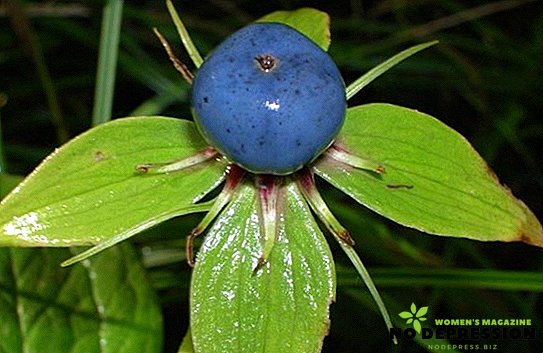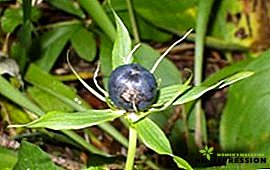A crowned eye is a poisonous forest plant that is best kept away from. However, such a wild-growing culture has a mass of healing properties and helps in the treatment of various pathologies. Often in the people such a plant is called "wolf berries", "raven", "armor" or "cross-grass". Proper preparation of the plant and compliance with the necessary dosages allows you to avoid side effects during treatment and alleviate the unpleasant symptoms of certain diseases.

Botanical description of the plant
Botanists consider the crow's eye a unique plant that belongs to the class of monocots and differs from its other representatives in the net venation of leaves. Another characteristic feature of a wild-growing culture is that its chromosomes are represented not in pairs, but in threes, fours, and even fives. Many genetics use such a plant as an ideal object for building scientific models.
 Crow's eye ordinary is a perennial herb that has a long rhizome and an upright stem. In the upper part of the culture is a whorl of four leaves, reaching lengths of up to 10 cm. In some areas, you can meet a crow's eye, which has five or six leaves at once.
Crow's eye ordinary is a perennial herb that has a long rhizome and an upright stem. In the upper part of the culture is a whorl of four leaves, reaching lengths of up to 10 cm. In some areas, you can meet a crow's eye, which has five or six leaves at once.
The leaves have a wedge-shaped base, and the tips are slightly pointed. At the top of the leaf is a flower, which has 8 stamens. The main period of flowering of such a wild-growing culture is May-June, only one flower is always formed. In August, one can observe the ripening of the plant and the formation of a single black berry on it, which is covered with a bluish bloom. It should be remembered that all parts of such a plant are considered poisonous.
When the first frost occurs, the upper part of the crow's eye dies. The rhizome is preserved, and in the spring of it begins to grow a new shoot. The main methods of reproduction plants are seed and vegetative, that is, with the help of rhizomes. When growing in favorable conditions, the crow's eye can grow and occupy large areas.
Growing area
Most often, it is possible to meet such a wild-growing culture when visiting mixed and deciduous forests, as well as on the slopes of ravines, among shrubs and pastures. Crow's eye prefers to grow on semi-shaded areas in the soil containing a lot of humus and a sufficient amount of moisture. Sometimes a wild-growing culture can be seen in coniferous forests and forest-steppes. The plant is considered quite common in the middle part of Russia, in Siberia, in the Caucasus, in Belarus and Ukraine.
Crow's Berries

Eating the crow's eye berries can be very dangerous for humans. Despite the pleasant smell and taste, when ingested, the berry causes irritation of the intestinal mucosa and adversely affects the work of the heart. In addition, the possible occurrence of such adverse reactions as nausea and vomiting, there is a violation of the nervous system.
The plant has an attractive appearance, so children often try to eat a crow's eye. However, after drinking the 10th berry, poisoning of the body occurs and death is possible.
It is possible to poison the fruits of the crow's eye when the dosage is exceeded, even if the culture is used to treat various diseases. It is for this reason that when using traditional medicine you must first consult with a specialist who will select the correct dosage and tell you about possible contraindications.
Chemical composition
 Crow's eye is considered to be a rather dangerous culture that can provoke even death. This is due to the presence of paristifin and paritin in the roots and berries of glycosides. The fact is that such chemical compounds have a marked toxic effect on the body. In addition, the composition of the crow's eye includes the following substances:
Crow's eye is considered to be a rather dangerous culture that can provoke even death. This is due to the presence of paristifin and paritin in the roots and berries of glycosides. The fact is that such chemical compounds have a marked toxic effect on the body. In addition, the composition of the crow's eye includes the following substances:
- steroid saponins help the plant to protect against pathogens;
- pectins allow you to maintain normal intestinal microflora;
- flavonoids have a strengthening effect on blood vessels and have a positive effect on the work of the heart;
- coumarins have a pronounced anticoagulant action.
In addition, the crow's eye is rich in various organic acids.
The plant is poisonous, and in folk medicine it is used as an anti-inflammatory, sedative, diuretic, and wound-healing agent. On its basis, various mixtures and tinctures are prepared, but self-treatment is best given up. The use of the crow's eye in traditional medicine is prohibited, as it contains a large amount of harmful substances.
Medicinal properties of the plant
Crow's eye is a fairly poisonous plant, but in dried form in small dosages it is widely used in medicine. Thanks to biologically active substances, the plant has the following effect:
 soothing;
soothing;- anti-inflammatory;
- antispasmodic;
- diuretic;
- wound healing.
In addition, with the help of such a plant can cope with:
- tuberculosis;
- laryngitis;
- ascites;
- migraine.
Crow's eye is used to improve appetite, eliminate tachycardia and normalize the bowels. A good effect is the use of funds based on the crow's eye in the treatment of convulsive syndrome and heart failure.
Cooking decoctions and tinctures
Traditional medicine recommends using the crow's eye for making infusions and decoctions that are effective in treating many diseases.
From a fresh plant at home, you can prepare the tincture on alcohol according to the following recipe:
- 50 grams of leaves should be poured into the dishes and 500 ml of vodka should be poured over them;
- leave the resulting mixture for 20 days in a dark place, then strain through gauze;
- during prolonged neurosis, 20 drops of such a folk remedy should be diluted in 200 ml of water;
- The treatment lasts 14 days, after which a short break is taken.

You can prepare an alcoholic tincture of the berries of the plant, and for this purpose fit both fresh and frozen fruits. It is necessary to pour 10 berries into a bottle of vodka with a capacity of 500 ml and leave the mixture to infuse for 14 days. Take a folk remedy should be as follows: 25 drops of tincture should be diluted in 20 ml of water. In the treatment of migraine should drink the drug several times a day for 3 weeks, after which the course is stopped.
For the treatment of conjunctivitis and blepharitis, you can use infusion from the collection, which is prepared from different parts of the following plants:
- bird cherry;
- raven eye;
- blue cornflower;
- meadow clover;
- meadow geranium flowers;
- shot open.
All components should be mixed together and a tablespoon of this collection pour 200 ml of boiling water. An hour later, the tool must be filtered and use liquid for lotions.
Symptoms of black eye poisoning
You need to know the symptoms that develops when the poisoning of the body is poisonous berries. It is necessary to seek medical attention if you see:
 nausea;
nausea;- vomiting;
- abdominal cramps;
- stool disorders;
- migraine;
- dizziness;
- discomfort in the throat and stomach;
- burning sensation in the mouth.
The severity of symptoms is determined by the number of berries that a person ate. If they are used too much, the following symptoms may be of concern:
- convulsive syndrome;
- muscle paralysis;
- speech problems;
- photophobia;
- dilated pupils;
- violation of cardiac activity, and even complete cardiac arrest.
In the event of poisoning with a raven eye, it is necessary to provide the victim with first aid as soon as possible.
First Aid

If symptoms of poisoning appear after eating a crow's eye, you must give the victim to drink activated charcoal and wash the stomach. To do this, drink plenty of water and induce vomiting. Such manipulations must be repeated several times in a row.
In case of poisoning it is necessary to eliminate irritation of the mucous membrane of the gastrointestinal tract. To do this, you can use a piece of ice, which should simply be swallowed. In addition to the measures taken, anesthesin should be administered, through which it will be possible to normalize the work of the heart.
Contraindications
It is strictly forbidden to take funds on the basis of the crow's eye in the following cases:
- the period of pregnancy and breastfeeding;
- hypersensitivity of the body to the individual components of the herbal remedies;
- age up to 12 years.
Before starting treatment with this plant, it is necessary to consult with a specialist. It is strictly forbidden to exceed the specified dosage, as poisoning of the body by toxic substances can occur. In addition, it is not allowed to use funds on the basis of the crow's eye for hypertension and insomnia.


 soothing;
soothing; nausea;
nausea;









